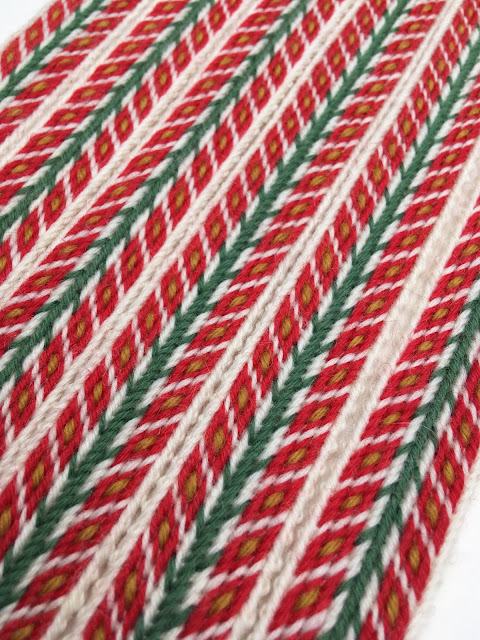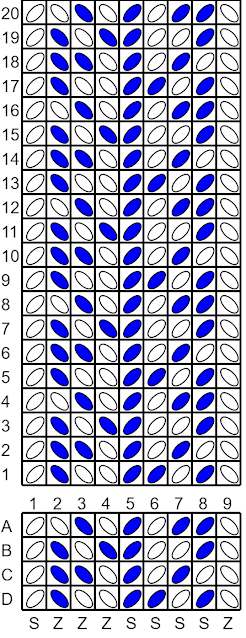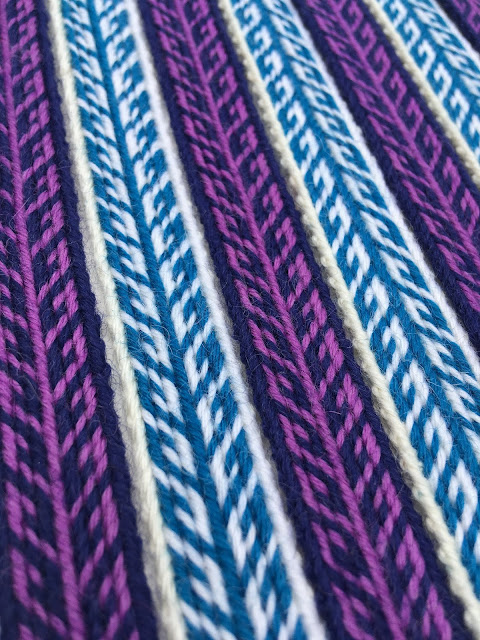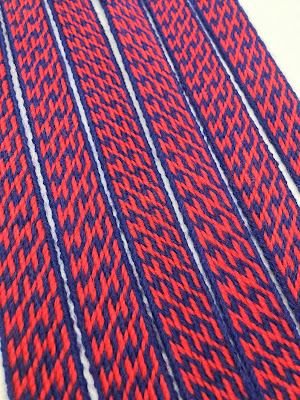Over the last year and a half or so, I've been working on the drafts for a tablet woven alphabet in the double-face structure and they're finally up for sale as Tablet Weaving in Theory and Practice: Double-Face Inscriptions.
 |
| The image from the front of my new book, reading "Psalmorum codex Anno domini 1457" |
You could say that this project began over a decade ago when I bought my copy of Linda Hendrickson's wonderful book Please Weave a Message, which remains one of the most well-thumbed volumes on my tablet weaving shelves (after Peter Collingwood's Techniques of Tablet Weaving, of course). I was utterly enchanted by her work and desperately wanted to follow in her footsteps and design a font of my own, but didn't yet have the know-how to do it.
 |
| A group of bands I wove back in 2013 as competition prizes using one of the fonts from Linda Hendrickson's book (you can definitely tell that I didn't know what kerning was at the time) |
Fast forward to the summer of 2017 when I had a number of long train journeys to while away (one of my favourite times to sketch patterns) and the idea took hold again. I drafted out full minuscule and majuscule alphabets based on a few pages from the Mainz Psalter that I'd found while searching for a suitable source (not a large enough sample size to make assumptions about the shapes of some of the minuscule letters, as it would later turn out). I then set aside the drafts until I had time to weave them. This was delayed by work on my first book in 2018, then again by my second book in early 2019. From August 2019, I was finally able to spend time on my letter drafts again. The original publishing deadline I set myself was November 2019, as I already had the drafts ready to go, but it coming back to them, I was able to see problems with their shapes, particularly the width of the lower case letters.
 |
| The sample woven from my first attempt at the drafts (top) and the next sample after the redesign (bottom) |
I stumbled upon the digitised version of the John Rylands Library copy of the Mainz Psalter online, which, after many hours of study, gave me the information I needed to re-work my letters. As the Rylands happens to be in the same city as me, I was able to become a library member and visit their Reading Room to look at some of their material about the Psalter (including a folio of hand written notes from 1888 by Russel Martineau, assistant keeper of the British Museum Library). I put off the launch date to March so that I could work in everything that I had learned.
 |
| Two more sample bands, with the final one from my book at the bottom |
Well, March came and March went. I had been almost ready for the first round of copy editing, when I started assembling words from my letters and directly comparing them to the Psalter, only to find that they really weren't right. I started to re-work the minuscule letters again, but when the pandemic hit, I decided to take a break. After all, it had been my free-time activity for 8 months at that point. I think the time it gave me away from the project helped me to come back to it fresh, with a more critical mind. It also helped that I had spent some of the intervening months doing further research on the Psalter.
 |
| The final black and white samples that are featured in my new book |















